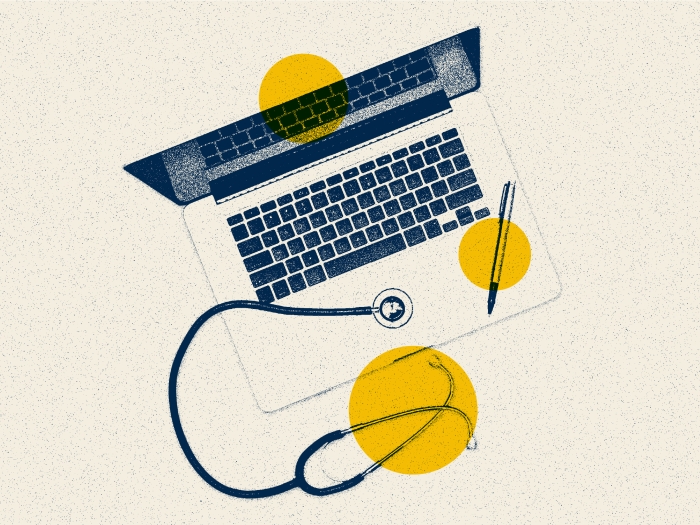When a retired nurse unexpectedly found herself as the patient in the emergency department, personally connecting with her care team made all the difference – even if they are college football rivals.
9:18 AM
Author |

In 2018, Carol started what she calls her "ongoing relationship with Michigan Medicine" with a visit to cardiologist, David Bach, M.D.
"I was diagnosed with breast cancer years ago and I was on a medication that they thought I should meet with a cardiologist to keep an eye on my heart," Carol says.
She had also experienced her first atrial fibrillation, or when the heart has an irregular and often rapid heartbeat, earlier in 2018.
Matthew Romano, M.D., a cardiac surgeon at Michigan Medicine, performed surgery on Carol's heart to replace a valve that wasn't functioning properly.
"I had to go back for a second surgery in October 2018, and that time I was feeling great afterward," says Carol, now 81 years old.
Then in the summer of 2019, she noticed her heart acting strange once again.
"I had another heart flutter and the beat wasn't like it should be," Carol says. "I'm hyper vigilant because I'm a retired nurse practitioner."
After wearing a heart monitor, she was referred to Hakan Oral, M.D., a professor of cardiac electrophysiology at Michigan Medicine, and in January 2020 had a cardiac ablation procedure to try to correct the abnormal heart beat. Sometimes multiple ablations are needed, though, to fully address it.
MORE FROM THE LAB: Subscribe to our weekly newsletter
"The first week of March I had an episode where my heart was racing, but it resolved after eight hours on its own," Carol says. "But then a couple of weeks later when I was getting testing done for that first episode, it happened again. My primary care doctor who was performing the testing said I should go to the emergency department."
Her heart rate was at 160 beats per minute at the time and had been staying that way for nine hours. But she was hesitant to go to the emergency department.
"This was the end of March and the COVID-19 pandemic was rearing its ugly head," she says.
Not just a patient, but a person
Carol's son drove her to the emergency department at Michigan Medicine.
"It was a smooth process as soon as we pulled up," she says. "There were three stations I had to go through when I got inside to answer questions, get a mask and take my temperature because of the pandemic, and my son wasn't allowed to come in with me, which I understood."
She laughs adding, "I mean within five minutes of pulling up to the door, I was in a room being swarmed on by so many wonderful people."
Because of her background in nursing, Carol says she always tries to get to know people.
"It's always been important to me to see the patient as a person, in addition to their heart condition or cancer diagnosis," she says. "So now that I'm the patient, I always ask the person taking care of me where they went to school, what they like to do outside of work and just try to get a feel for the person behind the mask."
SEE ALSO: Seeking Medical Care During COVID-19
Carol says that while her care team got to work checking her vitals and assisting her, she went to work asking her usual questions.
In the midst of the pandemic, we got to connect with the patient as a team of doctors, nurses, and trainees.William Meurer, M.D.
"She was stable, and the residents had tried a couple of measures to slow down her heart," says William Meurer, M.D., an associate professor of emergency medicine and neurology at Michigan Medicine. "I was coming in to help oversee the administration of adenosine, which reboots the heart by temporarily stopping it. This induces a fairly strange, unsettling feeling for a couple of seconds."
Meurer adds, "As we were discussing this, Carol noticed my Ohio State University lanyard."
"I had asked the residents where they went to school and they said that I hadn't asked where Dr. Meurer went to school," she says.
"I laughed and spelled out the word O-H-I-O with my arms," Meurer says. "Her heart just started beating normally, even before we gave her the medication."
Carol jokes, "Sure enough, Ohio State had done it again, which is a sad thing in Ann Arbor territory! I'm more of a Michigan State University fan, so it was just all around interesting!"
She adds that even with the uncertainty of the pandemic, her care team still made sure to understand her as a person.
"I was always treated like a person," Carol says. "They were busy in the emergency department that night and even with all of the fears of COVID-19 in the world, they still saw me as a person. Dr. Raphael Sweet even stopped by to say 'bye' before his shift ended."
Meurer agrees.
"It was a scary time to be a patient and a scary time to be a front-line health provider," he says. "It was rewarding that her SVT resolved, and it is fun for me to think my O-H-I-O arm motions contributed. In the midst of the pandemic, we got to connect with the patient as a team of doctors, nurses and trainees."
Monitoring her health
Carol says she has been serious about monitoring her heart health.
"I take my medications, I stay out of the sun, I keep on a low sodium diet and I lost a large amount of weight," she says.
And she stays active by walking and going for the occasional fly fishing trip.
"It's a strange time," Carol says. "I used to love traveling, but with the pandemic, I've canceled trips with my best friend. I'm definitely taking the pandemic seriously and making sure to be vigilant about washing my hands and limiting my family guests."
SEE ALSO: Keeping Our Patients Safe During COVID-19
Even though she is retired, Carol has been hoping she could try to help those with COVID-19 from afar.
"I'd love to do contact tracing because I did that type of thing as a nurse practitioner," she says. "But I don't think it's a good idea for me to be around people so I'm trying to think of things I can do that can keep my mind busy."
She says she still has the occasional arrhythmia and always keeps the phone number for her local emergency department handy.
"This latest episode is always in the back of my mind," Carol says. "I just know that I need to live my life, and pay attention to any warning signs."

Explore a variety of healthcare news & stories by visiting the Health Lab home page for more articles.

Department of Communication at Michigan Medicine
Want top health & research news weekly? Sign up for Health Lab’s newsletters today!





